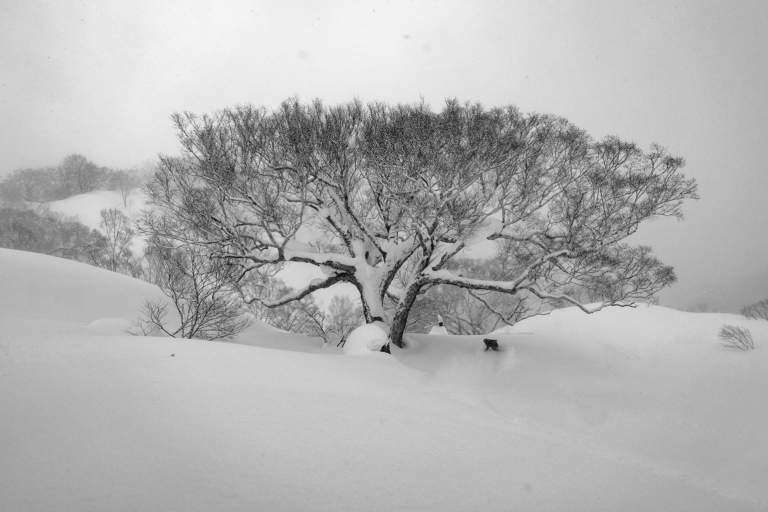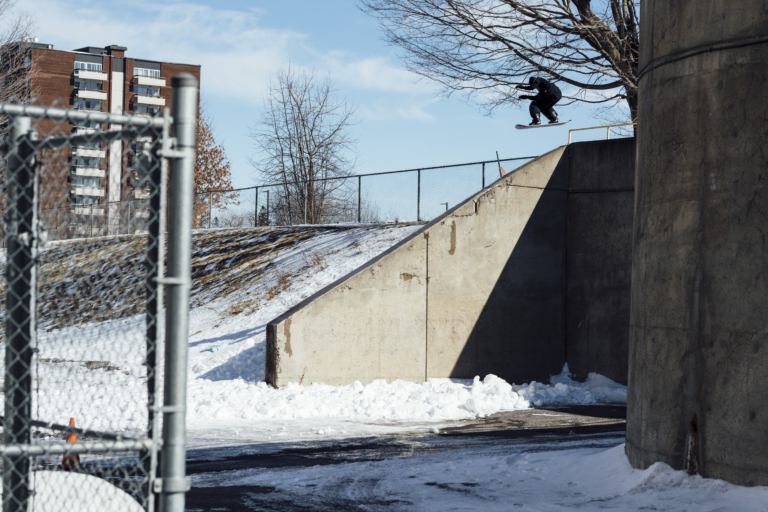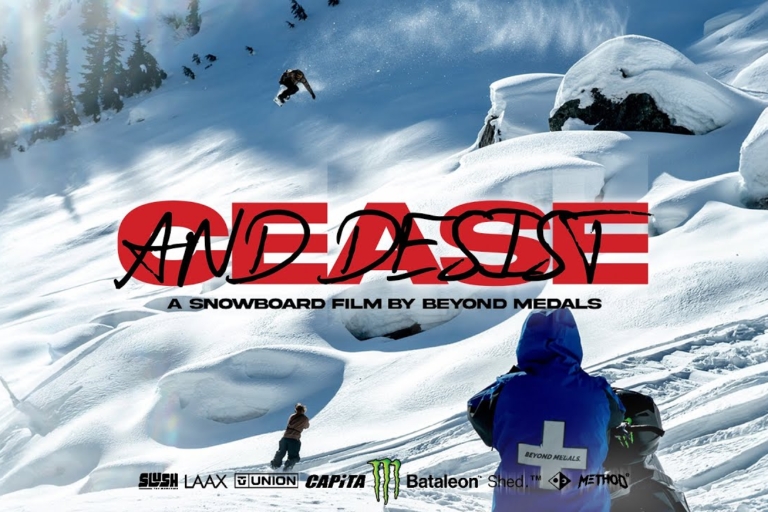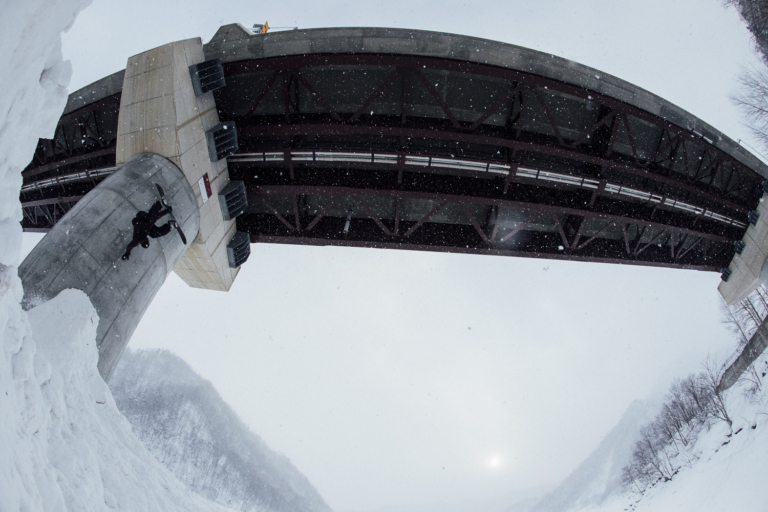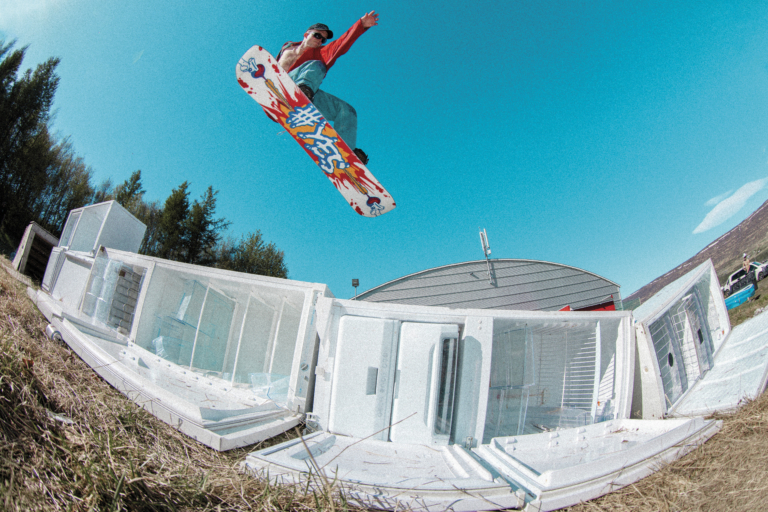I think the first time I met Austin Smith was fairly recently after I had started working at Snowboarder Magazine years ago. Austin and Bryan Fox came down to Southern California to guest edit an issue and they stuck around the office for the better part of a month. What I remember mostly is that Austin never had shoes on. And one day, Bryan brought doughnuts for everyone and Austin never did that. But what also struck me, is that from afar—from magazines and video parts and social media, I had always thought that Austin was one of the funniest people in snowboarding; he’s in possession of an incredibly dry, sarcastic sense of humor. Getting to know him only fortified this belief. But in addition to this, Austin pulls no punches on any serious note, either. He’s not interested in fluff, be it when guest editing a magazine, when having conversation, or in general, when going about his life and pursuing what he feels is important, in snowboarding or otherwise. In the years that have followed, the majority of my interaction with Austin has been through text messages, as he lives up in Oregon and I’m down in California. We’ll run into each other in the mountains from time to time, but while I haven’t gotten to spend too much time with him in person, I really value his perspective. He is clear about what he believes in and quick to admit when he needs to learn more. He’s the first to message about something he finds meaningful, and as he is so giving and transparent about his thoughts, I have always really appreciated and respected what he says—even if it takes me way too long to text back a lot of the time.
So, when Austin wanted to do things a little differently for his interview in this issue—in fact, not do an interview at all and instead write out his thoughts himself, I felt confident that his internal compass was worth following. Of course, this was before even reading what he had written (this is likely what people say to themselves when following Austin on any adventure he has planned). Of course, he delivered. So, in the following pages, Austin shares his thoughts on a few subjects that matter to him. Thanks, Austin. – Mary T. Walsh

It took me a long time to come to terms with it. For years I felt like I was trying to be someone I wasn’t. But once I accepted it and started saying it out loud, there was an immense relief. I felt lighter and at ease. In the scope of life, this thing is insignificant, but I felt different because of it and it can be weird to be different.
When I was 18, I had the opportunity to create my first pro model snowboard. Because I was insecure about this thing, I made my graphic about the thing, to create a false narrative and to be something I wasn’t, the definition of a poser. The graphic was a collab with 3 Inches of Blood, a hardcore heavy metal band. The thing wasn’t that band but music all together; I don’t care for music. I don’t hate music. I’m indifferent toward it. It feels good to accept this but now I am jealous, jealous of how much people love music and the way it moves them emotionally and physically. When I had the opportunity to meet 3 Inches of Blood, they could certainly see the imposter in me.
I say all this because I’ve come to terms with another reckoning, something I’ve been doing for a long time that I don’t like: interviews. I cringe reading spoken conversations, especially my own. During a conversation you have the space to go on rogue tangents, pivoting from banter to a serious topic, but it is challenge for that to translate well in print interviews. To make matters worse I’m awkward and uncomfortable being interviewed, so I default to overtalking and saying a bunch of shit that doesn’t make sense. Thank god for creating podcasts, a platform to broadcast conversations that ramble for multiple hours to the world. 10/10 for The Bomb Hole to be this medium in snowboarding. However, written words are slower and more intentional, and can carry more weight. Someone, somewhere took time to type letters onto paper, send them to a printer, and have them delivered to your doorstep. After all that effort it’s a bummer if those words do not reflect what you care about. SNOWBOARD Mag wanted to do an interview. I got a call from Nate Deschenes, someone I know of and respect. We chatted for hours and when I hung up the phone I thought, Woof, I blacked out. I wonder what I even said. After coming to terms with the fact that I don’t like interviews, I asked SNOWBOARD Mag if I could drink a bottle of wine and type on my computer what matters most to me at this point in my life.

INFERNO ON EARTH
As my younger self, I wasn’t anti Protect Our Winters, but I also was not an advocate for Protect Our Winters. I thought Jeremy Jones was a little bit of a hypocrite. I had skipped his part in TB10 flying around in helicopters; I’d rather watch Jeremy Jones’ part in Shakedown. At that time, it seemed like it had to be one or the other, jibber Jeremy Jones probably played into that by calling himself TRJJ, but it worked. I was on team jibber Jeremy Jones. As I got older, I realized you can see people as individuals despite having the same name as someone else. What are the odds of that? Two Jeremy Jones that were at the pinnacle of a new sport at the same time. And in hindsight, big mtn Jeremy’s TB10 part is great. Anyway, calling big mtn Jeremy Jones a hypocrite eradicated the possibility of someone calling me a hypocrite. I grew up with hippie parents, eating organic food and when I was 17, I converted my truck to run on waste vegetable oil. But at that same time, I had a snowmobile and I wanted to fly in the helicopters that big mtn Jeremy Jones was in. I was stuck between two worlds, aware of my impact on the world and wanting to be a pro snowboarder which inherently has a carbon footprint.
At some point I shifted teams, from being a critic of POW to being on their team, looking for solutions with them and learning from them. It’s a healthier and more productive team to be on. Did you know 100 corporations contribute 70% of greenhouse gases in the world? The problem is bigger than our personal actions, but the solution comes from unanimous support of clean air and clean water. Climate change is often referenced to preserving nature, snowy mountains, wetlands, wildlife refuges, tropical islands, and other majestic scenery, but the reality is that nature is in a fiftieth-floor apartment in NYC. Nature is in a prison cell. Nature is the freeway with gridlock traffic. Anything on planet Earth is part of the natural world. You don’t have to live in the woods and eat quinoa to care about the longevity of our fragile planet. If POW had the same support from outdoor enthusiasts that the NRA has from gun enthusiasts, it would be a political juggernaut, and that is what we need.

BRAIN PROTECTION
This has been a recurring conversation with Smith Optics. They’ve asked me to wear a helmet and I’ve stubbornly been reluctant. 1997 was the last year an NHL player did not wear a helmet. It’s crazy that at one point, no NHL players wore helmets, not even the goalies. And as recent as 1997 there was one last, stubborn hockey player who refused to put on a brain bucket. This past winter was the first year I realized I am in the minority in the lift line when not wearing a helmet. I grew up wearing one. I don’t remember having a conversation with my parents or making a decision to wear one, it’s just what I did.
I wore one up until the day I started filming for video parts. I vividly remember hearing a movie producer saying, “You want the helmet kid in the movie?” That was the end of me wearing a helmet and through snowboarding I’ve been knocked out and woken up in the hospital multiple times. In theory, and what I have convinced myself for many years is my decision to not wear a helmet has no impact on your life. But the argument can be said, I am contributing to the facade of what is cool and what is not, at a professional level. If “Jimmy” had a bad head injury from snowboarding that was preventable by wearing a helmet, that weight does fall on the shoulders of those who are promoting that.

It is interesting cultural norm that dictates whether we wear helmets. I heard it was Pinkbike that created the change in mountain biking. They said they wouldn’t publish a photo of someone not wearing a helmet. I wonder if Thrasher or Transworld drew that same line in the sand, what the results would be. Pro snowboarders want to be pro snowboarders, risking life and limb to get there and if that meant wearing a helmet to get there, not many would hesitate. I will start wearing a helmet one day, although I feel like my most reckless and risky behavior is behind me. Rather than deciding when to put your helmet back on it is a lot easier if you never take it off. Kudos to the Warbingtons! I wonder who will be the Craig MacTavish of snowboarding?
SMITH VERSES SCHUYLER
My name is Austin Smith and my older brother’s name is Lebn Schuyler. It was weird explaining that as a kid. My parents never got married so he got my mom’s last name and I got my dad’s. They felt bad that no one could pronounce his name, so I got a super basic one. With that explanation, there were always follow up questions. “Are they your real parents? Is he you real brother? Why aren’t they married?” To my knowledge, they are my real parents and they had not gotten married because same sex marriage was illegal, and while they were a heterosexual couple, they did not want to support the institution of marriage. Once same sex couple marriage became legal in 2014, they got married. It was quite the stubborn display of standing up for what you believe in, similar to the helmetless hockey player but with more empathy for other people.
That was my introduction to marriage, partners, and sexuality. During my teenage years, any time I had a close male friend, my mom would ask me if we were gay; she hoped for it and in turn, she also normalized it. As a result of a handful of people, it is becoming normal conversation in snowboarding. Pride stickers have become the modern-day Grenade stickers. Supporting each other for who each person is has become “cool” and that is the best thing to happen in snowboarding since highbacks.
Part of inclusivity is access. I remember being judgmental of Snowdays, a youth-empowering program that takes kids snowboarding that was founded by Travis Parker back in 2004. Questioning the impact of taking a kid snowboarding just one day, I thought it was kind of like dangling a carrot that someone can’t have. There is so much wrong with that mentality and it took me all of about twenty minutes with a group of Snowdays kids to realize how I couldn’t have been more wrong. However, trying to teach someone how to snowboard their first time is pretty funny. Strap a big piece of plastic to one foot and shuffle yourself across the snow; it is all very unnatural.
Inclusivity feels like a new and trendy term in snowboarding, but it only takes a few minutes of research to realize the abundance of organizations that have been doing this work for decades: Big Sky Youth Empowerment, Hoods to Woods, SHRED Foundation, SOS, Chill, STOKED, Service Board, etc. Maybe it is me getting old and not being able to keep up with the latest tricks, but snowboarding needs these orgs more than a pentacork. I can’t recommend volunteering enough; contribution to snowboarding, purpose and perspective, is healthy on all accounts.

SEASON’S CHANGE
I consistently struggle with my purpose in the world. Struggling with purpose is not unique to me or pro snowboarders, although we might be more egomaniacal than most. We ask people to spend their time and energy taking our picture and filming us doing tricks sliding down the snow. Then those pictures and movies are leveraged by brands to sell stuff—so much stuff, an endless cycle of stuff. In an effort to question the annual consumer culture of snowsports, Eric Pollard and I started a ski and snowboard company, Season EQPT. A bit hypocritical, we were frustrated with the general excess in snowsports, so we decided to contribute more to it. But this feels like my purpose: question what I see as faults in snowboarding and offer a solution to them. Snowboarding equipment is durable, all of it. That’s why lots of brands offer a lifetime warranty on their products—even the Smartwool socks I wear come with a lifetime warranty. But what isn’t durable is marketing, selling a new colorway every season to encourage people to replace their existing and functional product with the new color. In an attempt to break this mold, we need to approach skis and snowboards like you treat hammers or cameras. You replace a hammer if yours breaks. Your hammer is a tool to build things, a snowboard is a tool to get you into the mountains. The longer and more you use a camera the better it gets, the deeper the connection becomes and more memories are created. The same can be said for a snowboard. Some of our hopes are ambitious: disrupt consumer culture. But others are simple: offer a simplified menu with fewer options, while highlighting a spectrum of snowsport enthusiasts, young, old, pro, novice, boy, girl, snowboard, ski. Growing up at Mt. Baker, no one cared about what gear you had or how old it was, but through my time as pro snowboarder I’ve gotten caught in the consumer vortex. Season is my ticket out of it.

GOAT
As mentioned before I’m a Bomb Hole fan and while we established I don’t like music I claim to be an early adopter to podcasts, I had to listen to something driving up and down the west coast chasing storms to film video parts and it surely wasn’t 3 Inches Of Blood. I’m envious of Chris and E-Stone, the conversations they get to have and the contribution to snowboarding is worth celebration. One of my favorite questions of theirs is who is the Greatest of all Time? Chris often chimes in with some bullshit about the GOAT as it pertains to his personal experience growing up riding rails on the east coast. You can have local legends and influential people but there is only one GOAT of snowboarding. I’ve been thinking about my answer, in case I ever got invited onto the show but luckily for all of us that has not happened. The most obvious and easiest answer will always be Craig Kelly. He embodied snowboarding in the purist and most authentic way possible. However, remembering and putting people on a pedestal whom have passed away can be muddy. As time goes on and I remember my dad and paint a picture of who he was, he only gets better with time. The fond memories grow stronger as we repeat those stories and if there were any negatives they have been forgotten. I don’t say that to discredit or disrespect Craig but I think it creates an added complication and he is the late GOAT. Secondly how do we measure greatness? Unfortunately, in our culture it is predominately by money. Musk and Bezos are considered to be winning the game of life, despite the fact they are self-centered, egotistical maniacs. My nomination for person winning at life is this nerdy kid Boylan Slat. Ss a teenage he set out to clean up the giant garbage island in the ocean. In snowboarding though, greatness is usually measured by talent and tricks. Shaun White is arguably the greatest competitor and illuminated snowboarding in a spotlight on a global stage. But I don’t think he is the GOAT, even though I cherished and bragged about a pair of pants his mom gave me when I was a camper at Windells.
Greatness should be measured by your contribution to something, in this case snowboarding. Travis Rice is a human Swiss army knife in this regard. He has pioneered tricks, created the most-watched films, and relentlessly works toward progressing contests. But his contributions have come with fame and fortune and the GOAT must embody attributes of an actual goat. Travis is more of a lion, the king of the Jungle.
After months of personal debate, my pick for the GOAT of snowboarding is the person who has spent 10,000-plus hours snowboarding, filming and editing. He has embodied, showcased, and preserved snowboarding at its simplest form: dorking around with your friends. I was never in his movies, which gives me an unbiased opinion. However, I was one of his several hundred campers that he coached at High Cascade. Snowboarding’s GOAT is Jesse Burtner.

The End
The best part of a spoken interview is it’s easy to tell when it’s over. “So, you got anything else you want to say? Anyone you want to thank?” With this Dear Diary format, I can keep typing endlessly. But the wine is gone and I’m having a hard time remembering where we began. We all live in the natural world called Earth and we need to take care of it. The most impactful tools we have are who and what we vote for with our ballot and dollar. If you want a memory better than mine, wear a helmet. I’ve snowboarded for Smith for fourteen years and I’ve never worn one of their helmets for a full day. That is a sad reality I’m going to change. Give your gear a good audit and ask yourself if you need new gear or if you want new gear. Fixing gear is the most sustainable solution. Let’s measure success by contributions, all hail Burtner.
Treat people with kindness, regardless of who they love, how they slide down the mountain, or if they scooter—I’m tired of scooter shit talking. Be yourself. When I created the 3 Inches of blood graphic, I was trying to be cool, and that was uncool.
Thank you, SNOWBOARD Mag, for the pages to ramble.


